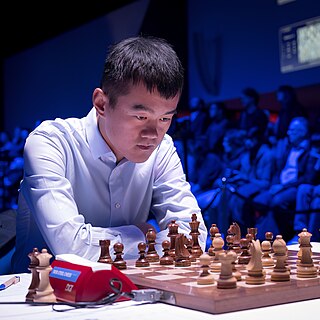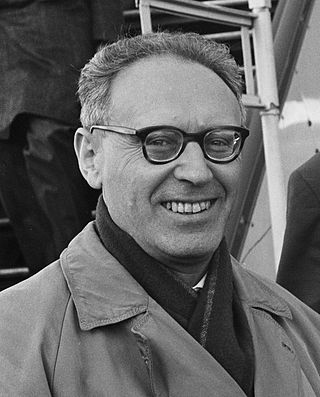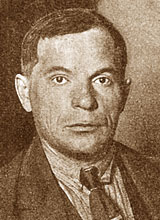
The International Chess Federation or World Chess Federation, commonly referred to by its French acronym FIDE, is an international organization based in Switzerland that connects the various national chess federations and acts as the governing body of international chess competition. FIDE was founded in Paris, France, on July 20, 1924. Its motto is Gens una sumus, Latin for 'We are one Family'. In 1999, FIDE was recognized by the International Olympic Committee (IOC). As of December 21, 2023, there are 201 member federations of FIDE.

Alexander Aleksandrovich Alekhine was a Russian and French chess player and the fourth World Chess Champion, a title he held for two reigns.

The World Chess Championship is played to determine the world champion in chess. The current world champion is Ding Liren, who defeated his opponent Ian Nepomniachtchi in the 2023 World Chess Championship. Magnus Carlsen, the previous world champion, had declined to defend his title.

José Raúl Capablanca y Graupera was a Cuban chess player who was the third world chess champion from 1921 to 1927. A chess prodigy, he is widely renowned for his exceptional endgame skill and speed of play.

Mikhail Moiseyevich Botvinnik was a Soviet and Russian chess grandmaster who held five world titles in three different reigns. The sixth World Chess Champion, he also worked as an electrical engineer and computer scientist and was a pioneer in computer chess. He also had a mathematics degree (honorary).

Emanuel Lasker was a German chess player, mathematician, and philosopher. He was the second World Chess Champion, holding the title for 27 years, from 1894 to 1921, the longest reign of any officially recognised World Chess Champion in history. In his prime, Lasker was one of the most dominant champions, and he is still generally regarded as one of the strongest players in history.

Géza Maróczy was a Hungarian chess player, one of the leading players in the world in his time. He was one of the inaugural recipients of the International Grandmaster title from FIDE in 1950.

Edward Lasker was a German-American chess and Go player. He was awarded the title of International Master of chess by FIDE. Lasker was an engineer by profession, and an author of books on Go, chess and checkers. Born in Prussia, he emigrated to the United States in 1914. He was distantly related to World Chess Champion Emanuel Lasker with whom he is sometimes confused.
Several methods have been suggested for comparing the greatest chess players in history. There is agreement on a statistical system to rate the strengths of current players, called the Elo system, but disagreement about methods used to compare players from different generations who never competed against each other.

Andor Arnoldovich Lilienthal was a Hungarian and Soviet chess player. In his long career, he played against ten male and female world champions, beating Emanuel Lasker, José Raúl Capablanca, Alexander Alekhine, Max Euwe, Mikhail Botvinnik, Vasily Smyslov, and Vera Menchik.

Alexander Fyodorovich Ilyin, known with the party name Zhenevsky, "the Genevan" because he joined the Bolshevik group of Russian émigrés while exiled in that city, was a Soviet chess master and organizer, one of founders of the Soviet chess school, an Old-Guard Bolshevik cadre, a writer, a military organizer, a historian and a diplomat. He was born in Saint Petersburg and was the younger brother of Red Navy leader Fedor Raskolnikov.

Charles Jaffé (Jaffe) was a chess master and chess author born in the Russian Empire.

Fedor (Fyodor) Ivanovich Duz–Khotimirsky was a Russian Empire and Soviet Ukrainian chess master. He was one of the organizers of the Kyiv Chess Club.
The Nottingham 1936 chess tournament was a 15-player round robin tournament held August 10–28 at the University of Nottingham. It was one of the strongest of all time.
The Hastings International Chess Congress is an annual chess tournament which takes place in Hastings, England, around the turn of the year. The main event is the Hastings Premier tournament, which was traditionally a 10 to 16 player round-robin tournament. In 2004/05 the tournament was played in the knock out format; while in 2005/06 and 2006/07 it was played using the Swiss system. Alongside the main event there is the challengers section, which is open to all players. The winner of the challengers event earns an invitation in the following year's Premier.

The 1921 World Chess Championship was played between José Raúl Capablanca and Emanuel Lasker. It was played in Capablanca's native Havana from March 18 to April 28. Capablanca won the match by a score of 9-5 to become the third World Chess Champion.
Jacob Bernstein was an American chess master.
The St. Petersburg 1914 chess tournament was one of the most famous chess tournaments of the early twentieth century. It included almost all the leading players of the time, and was won by World Champion Emanuel Lasker, who came from behind to narrowly defeat future World Champion José Raúl Capablanca. Another future World Champion, Alexander Alekhine, finished third, ahead of the former World Championship contenders Siegbert Tarrasch and Frank Marshall.
A school of chess denotes a chess player or group of players that share common ideas about the strategy of the game. There have been several schools in the history of modern chess. Today there is less dependence on schools – players draw on many sources and play according to their personal style.
Moscow 1935 was the second international chess tournament held in Moscow, taking place from 15 February to 15 March 1935. Salo Flohr and future world champion Mikhail Botvinnik tied for first, followed by former world champions Emanuel Lasker and José Raúl Capablanca.
 Efim Bogoljubov (Soviet Union)
Efim Bogoljubov (Soviet Union) Emanuel Lasker (Germany)
Emanuel Lasker (Germany) José Raúl Capablanca (Cuba)
José Raúl Capablanca (Cuba) Frank James Marshall (United States)
Frank James Marshall (United States) Savielly Tartakower (Poland)
Savielly Tartakower (Poland) Carlos Torre Repetto (Mexico)
Carlos Torre Repetto (Mexico) Richard Réti (Czechoslovakia)
Richard Réti (Czechoslovakia) Peter Romanovsky (Soviet Union)
Peter Romanovsky (Soviet Union) Ernst Grünfeld (Austria)
Ernst Grünfeld (Austria) Alexander Ilyin-Genevsky (Soviet Union)
Alexander Ilyin-Genevsky (Soviet Union) Fedor Bogatyrchuk (Soviet Union)
Fedor Bogatyrchuk (Soviet Union) Boris Verlinsky (Soviet Union)
Boris Verlinsky (Soviet Union) Rudolf Spielmann (Austria)
Rudolf Spielmann (Austria) Akiba Rubinstein (Poland)
Akiba Rubinstein (Poland) Grigory Levenfish (Soviet Union)
Grigory Levenfish (Soviet Union) Ilya Rabinovich (Soviet Union)
Ilya Rabinovich (Soviet Union) Fred Yates (England)
Fred Yates (England) Friedrich Sämisch (Germany)
Friedrich Sämisch (Germany) Solomon Gotthilf (Soviet Union)
Solomon Gotthilf (Soviet Union) Fyodor Duz-Khotimirsky (Soviet Union)
Fyodor Duz-Khotimirsky (Soviet Union) Nikolai Zubarev (Soviet Union)
Nikolai Zubarev (Soviet Union)











